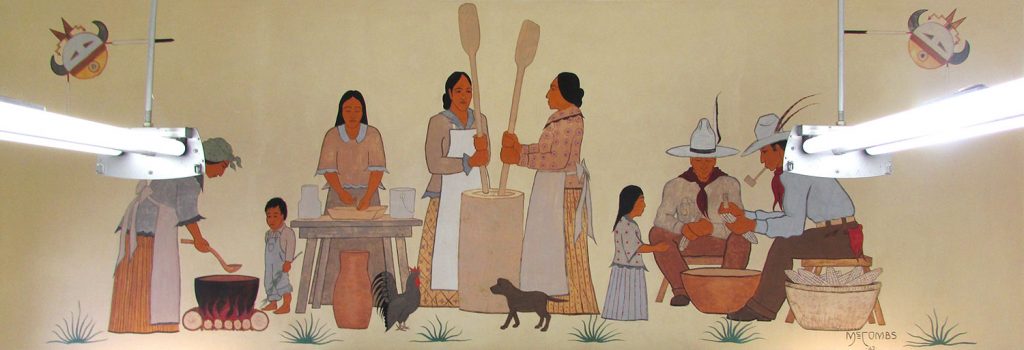Description
This is a single story Federal Revival style building in buff brick. The building has a basement, and a very slightly hipped roof with a louvered cupola that is topped with a weather vane. A limestone entablature at the top of the walls is mirrored by a limestone sill course at the foundation. A wide stairway rises to a double door entrance that is distinguished by a fluted door surround topped with a metal eagle over the doors. Four windows spanning the symmetrical facade are “framed” by brick window surrounds that are recessed slightly from the main wall surface. In 1942, with a Section commission, Solomon Mccombs painted a mural inside on the west wall That mural, Chickasaw Family Making Pah Sho Fah, was restored in 1963 but still shows considerable wear today. In numerous places the paint has chipped off, leaving noticeable white spaces where colors should be. The mural is an important piece of New Deal art but questions about the nature of the restoration necessarily raise questions about the integrity of the work. For this reason the building and the art are recommended for further study.
Chickasaw Family Making Pah Sho Fah

by Solomon McCombs, 1942, oil on plaster.
Chickasaw Family Making Pah Sho Fah was one of the last murals painted in the mural program. World War II had created a canvas shortage forcing McCombs to paint the mural directly on plaster. This technique created some instability and the mural was restored in 1963 by Creek artist Fred Beaver.
McCombs’s Creek heritage informed most of his work, including Chickasaw Family Making Pah Sho Fah, and he became well known in the 1940s for his genre images of Creek life. His paintings generally capture the Creek past of his youth, particularly in the inclusion of historic dress and architecture; however, the rituals and beliefs depicted in the paintings persist in contemporary Creek culture, suggesting a continuity between past and present. Chickasaw Family Making Pah Sho Fah illustrates the preparation of a flint corn beverage, also known as pishafa, which is popular among Creeks and other tribes of a Southeastern origin. McCombs steps through the process beginning with the men at right that shell the com and leave it to soak in water. The women at center pound the soft corn into meal and the single woman at their right separates the husk from pulp. The meal is then cooked by the woman at extreme left. McCombs demonstrates a careful attention to form and details of dress while reducing the surrounding landscape to a series of stylized plants. His style displays the common characteristics of the Traditional Indian Painting style that dominated instruction at Bacone College, where he had trained under Blue Eagle.
Sources
- Thematic Survey of New Deal Era Public Art in Oklahoma 2003-2004, Project Number: 03-401 (Department of Geography, Oklahoma State University).
- https://postalmuseum.si.edu/indiansatthepostoffice/mural3.html
- Originally posted in the New Deal Art Registry
- The Living New Deal
- Oklahoma Landmarks Inventory Nomination



Recent Comments